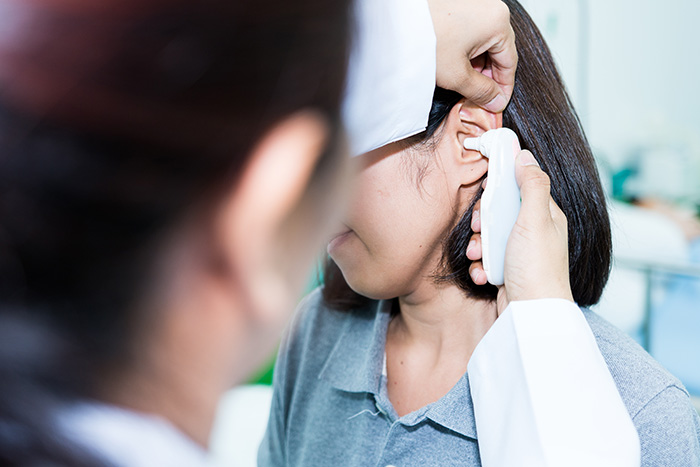Common Ear-Related Problems In Babies
Middle ear infection (acute otitis media and otitis media with effusion), outer ear infection, glue ear and wax problems are the most common ear-related problems commonly seen in children.1,2,3 Ear infections are widespread in infants and toddlers primarily when they are around 6 and 18 months.2 Generally, five out of six children may experience an ear infection at least once before they turn three.4
Understanding common ear problems in kids
The different types of ear problems and their symptoms are listed below.
Middle ear infection: This is the most common infection type. A middle ear infection occurs when viruses and bacteria enter the ear from the throat via the eustachian tube (a region behind the throat that goes up to the middle ear). This usually happens after a cold, sore throat or other infection of the upper respiratory tract. Children’s eustachian tubes are narrow and small, making them vulnerable to middle ear infections. Their eustachian tubes lengthen as they grow in age, making them less susceptible to ear infections. Infection in kids can also occur because of sinus-related allergies.2,4 Moreover, fluids may get accumulated because of infection, which may exert pressure on the child’s eardrum. In such cases, relieving the pressure by draining the fluid from the baby’s ear should be the priority because the increased pressure may cause bursting of the eardrum.
Ear infections can be uncomfortable during the first two to three days; using pain relievers at such a time may calm the baby. Your baby may show symptoms that indicate infection such as earache, fever, headache, mild loss of hearing, fluid discharge from the ear, irritability, constant pulling of the affected ear, loss of appetite, and sleep difficulties.3,4 However, after a few days, the infection usually goes away on its own. Moreover, middle ear infections are unlikely to affect children of ages six or above as their eustachian tube matures.2,3,4
As a precautionary measure to prevent such infections, you may want to limit your baby’s exposure to other children because it increases the chances of your baby catching a cold.3,4 Please do not forget to get your baby vaccinated against influenza or flu.1,4 Breastfeeding is advisable over bottle-feeding till the recommended age because it enhances the baby’s immunity and helps them fight against such infections. Allowing your baby to drink milk while lying in a propped-up position is not a good idea.1,3 Moreover, avoid smoking around the child as passive smoking is one of the causes of ear infection in babies.1,3
Outer ear infection: This is known as ‘swimmer’s ear’ or otitis externa. If your child swims in unclean water or if their ear canal is damaged, they can develop an outer ear infection. The usage of cotton buds for cleaning may injure your child’s ear canal. In certain instances, an outer ear infection may occur because of foreign bodies such as insects or objects. If this happens, you should immediately visit the doctor to get them removed. In case of such an infection, the infected area may be swollen, red, and painful.2
Glue ear: This is a common condition that occurs after a middle ear infection. Glue ear in itself is not an infection. This condition may block your baby’s hearing because of fluid build-up.2,3
Ear wax: Too much of ear wax may impair your child’s hearing.3
What can you do if your baby develops ear problems?
Visit your baby’s doctor or an ear, nose and throat specialist. For a diagnosis, the doctor may ask you about your child’s health and other conditions or use a tool to check the eardrum. Based on the diagnosis, the doctor may prescribe pain relief, oral antibiotics or antibiotic/anaesthetic ear drops. However, in certain cases, a small surgery may be required. For ear wax build-up, the doctor can remove it with a syringe and warm water.2,3,4
References:
- Goodman DM, Lynm C, Livingston EH. Ear Problems in Children. 2013;309(21):2284. doi:10.1001/jama.2013.4428.
- Pregnancy birth & baby. Ear infections in babies and children [Internet] [Updated June 2020]. Available at: https://www.pregnancybirthbaby.org.au/ear-infections-in-babies-and-children Accessed on May 7, 2021.
- Better Health Channel. Ear problems in children [Internet] [Updated Oct 31, 2012]. Available at: https://www.betterhealth.vic.gov.au/health/ConditionsAndTreatments/ear-problems-in-children Accessed on May 7, 2021.
- National Institute on Deafness and Other Communication Disorders. Ear infection in children [Internet] [Updated May 12, 2017]. Available at: https://www.nidcd.nih.gov/health/ear-infections-children Accessed on May 7, 2021.

